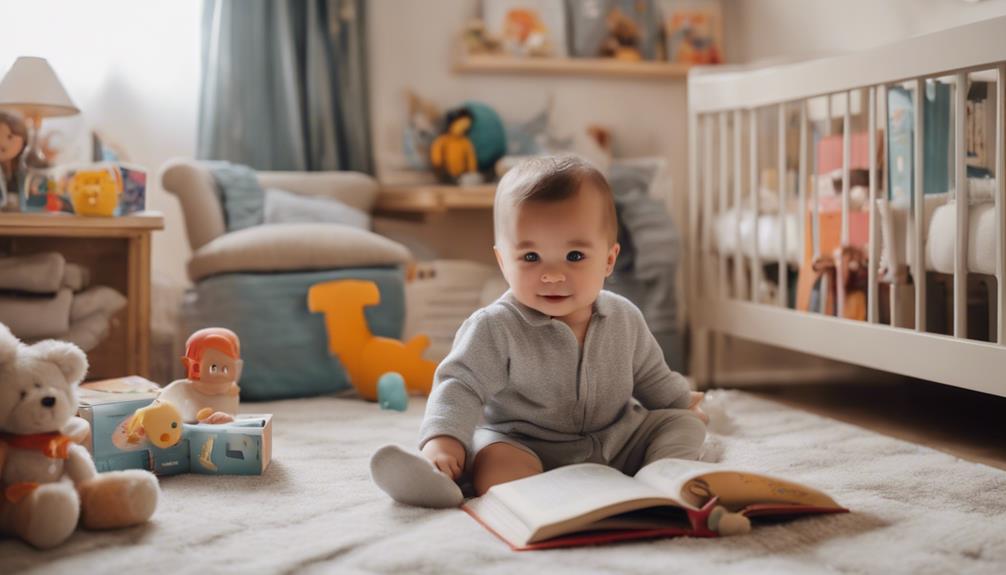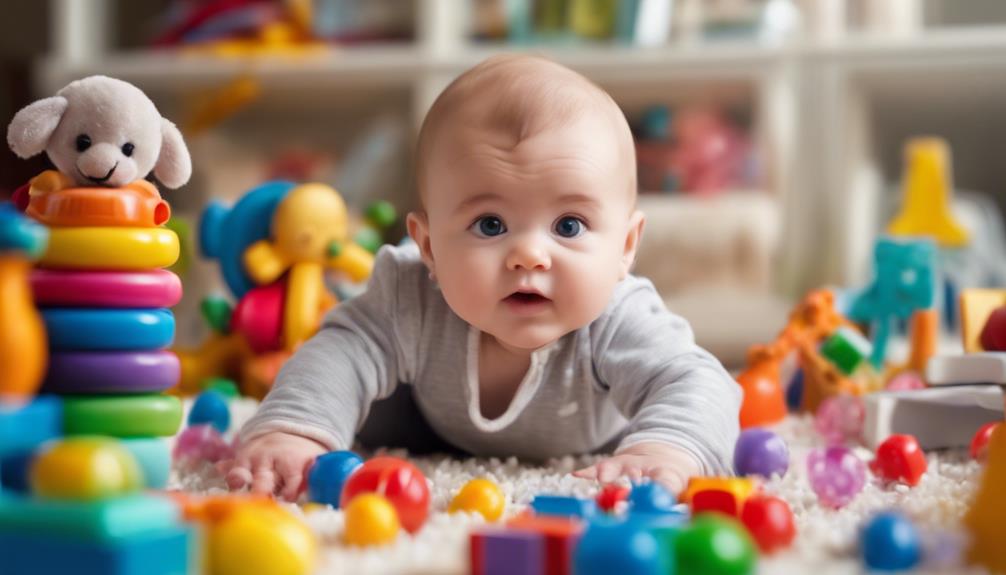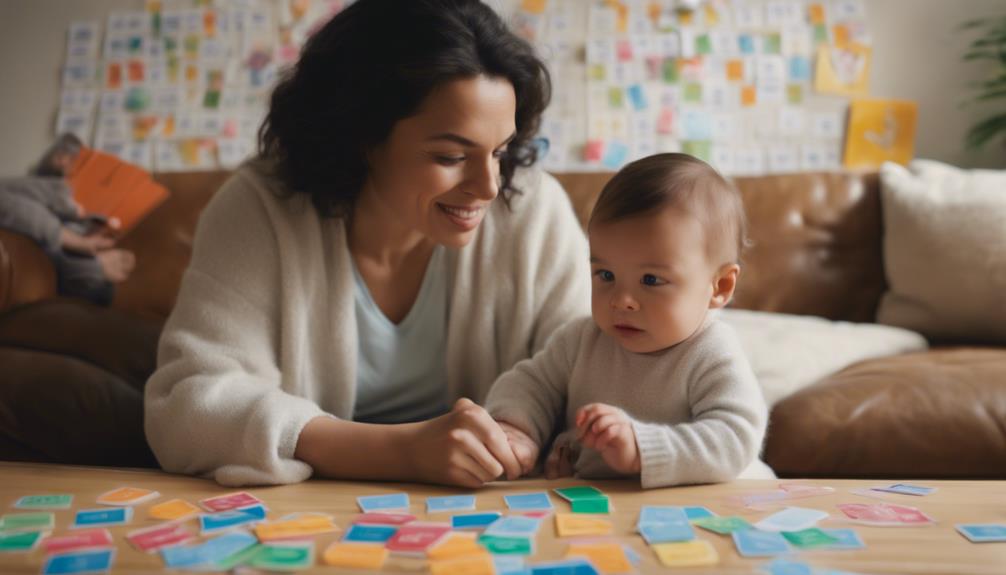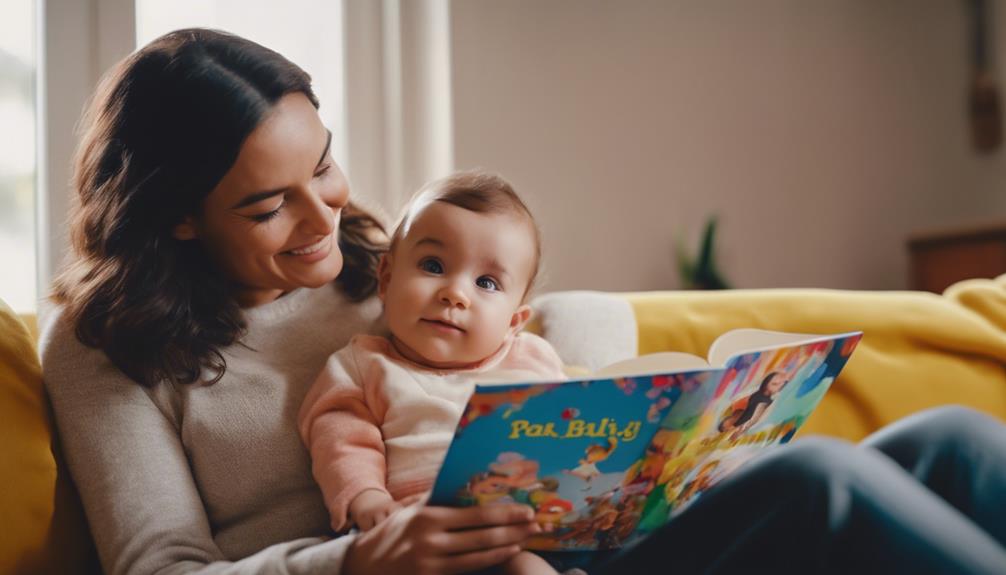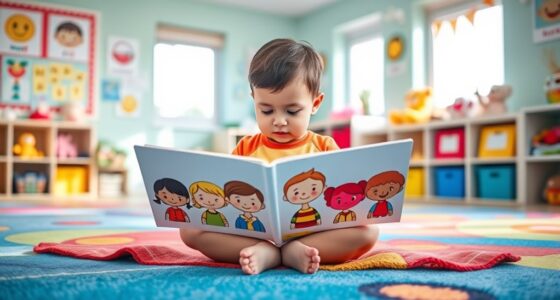Start introducing your baby to reading from 0-9 months. This early exposure helps with language development and encourages a love for learning. Choose tactile and interactive books to improve language skills efficiently. Participate in regular reading sessions to increase vocabulary. Use books with captivating illustrations and interactive elements. Maintain a rhythmic language flow for better engagement. Reading at an early age can set the stage for academic achievement. If you’re interested in learning more about establishing a strong reading foundation for your baby, there is a wealth of information to discover.
Key Takeaways
- Start introducing books and reading activities from 0-6 months.
- Look for signs of readiness like interest in books and words.
- Begin teaching letters, sounds, and simple words around 1-2 years.
- Adjust teaching methods based on the child's pace and responses.
- Create a supportive and engaging learning environment for effective teaching.
Early Exposure to Books
Introduce books to your baby as early as 0-9 months to foster a love for reading and language development. Starting too early isn't a concern when it comes to exposing your little one to the world of books.
In fact, research shows that infants benefit greatly from early exposure to books with tactile and interactive features. These books, with flaps to lift and textures to touch, engage your baby's senses and help in developing a strong foundation for language skills.
According to experts, regular reading activities starting at an early age can have a profound impact on your baby's vocabulary development. By the age of 18 months, babies who've been exposed to books from as early as six months show a 40% increase in receptive vocabulary. See and say books, which involve pointing out and describing pictures, are particularly beneficial for infants in expanding their vocabulary.
Early exposure to books with fun textures, sounds, and simple plots can ignite a passion for reading in your baby, setting the stage for a lifelong love of literature.
Signs of Readiness

Start noticing signs of readiness in your baby by observing their interest in books, letters, and storytelling. Look for your baby following stories or sequences, showing curiosity about words and their meanings, and demonstrating a desire to engage with printed materials. Recognizing letters and sounds is an important step towards reading readiness. To help you understand these signs better, here is a table summarizing key indicators of your baby's readiness for learning to read:
| Signs of Readiness for Teaching Reading | Description | Importance |
|---|---|---|
| Interest in books | Showing enthusiasm towards books and stories | Develops a love for reading early on |
| Curiosity about words | Displaying interest in written words | Indicates a desire to learn and explore |
| Recognizing letters and sounds | Identifying letters and their corresponding sounds | Essential for building foundational reading skills |
Observing these signs in your baby can guide you in determining when to start teaching reading effectively.
Reading Readiness Activities
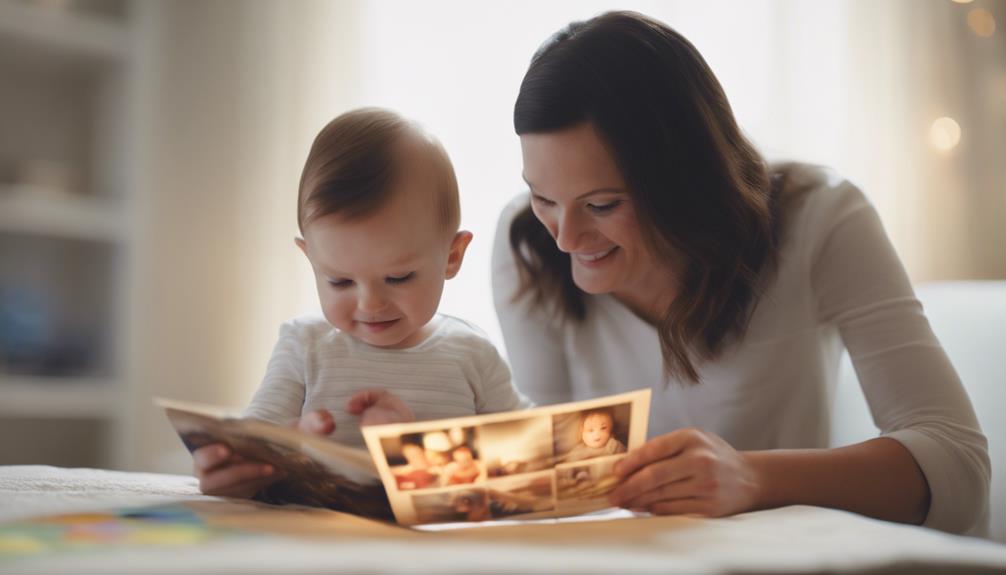
Reading readiness activities are essential in laying the foundation for early literacy skills. By introducing interactive storytime routines, you can engage babies in the world of books and words.
Pointing out pictures and describing them helps in vocabulary development and visual recognition.
Early Literacy Skills
Begin fostering early literacy skills in babies by engaging them with tactile books, simple board books, and picture books to lay a strong foundation for language development.
Introducing these materials at a young age can have a profound impact on their early reading abilities. Research has shown that regular reading sessions with infants can lead to a remarkable increase in their receptive vocabulary by the time they reach 18 months old.
By pointing out and describing the pictures in books to your child, you can actively contribute to their vocabulary growth and enhance their language comprehension skills. Additionally, incorporating fun textures, flaps, and interactive elements into reading materials can further stimulate your child's interest in reading and learning.
According to child development experts, these early literacy activities play an essential role in preparing young children for future academic success. Invest in these reading readiness activities to set a strong foundation for your child's literacy journey.
Interactive Storytime Routines
Engage babies and toddlers in interactive storytime routines to cultivate their reading readiness skills. Reading aloud with engaging sounds and actions can captivate young children's attention.
Incorporating touch-and-feel books, lift-the-flap books, and interactive elements can enhance learning.
Using repetition, rhymes, and songs during storytime can aid in language development.
Encouraging children to ask questions, point to pictures, and participate actively can foster a love for reading.
Building a Reading Routine
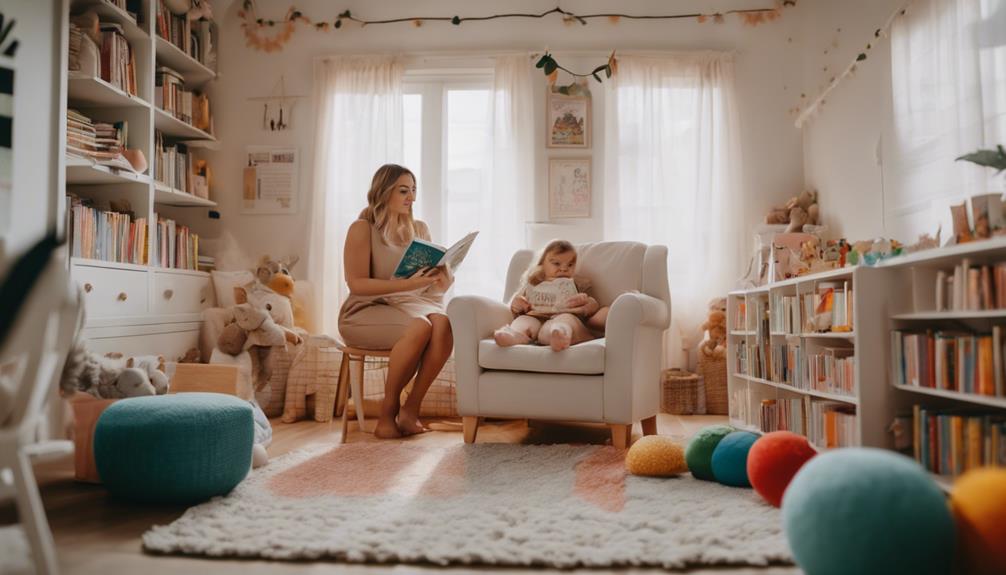
To establish a strong foundation for your baby's reading skills, initiate a consistent daily routine that includes interactive book sessions starting around 6 months old.
Reading to children from a young age is vital for their language development. Research shows that regular reading sessions with babies can greatly enhance their receptive vocabulary by the age of 18 months. Engaging in interactive reading activities, such as pointing out pictures and describing them, can further boost their language skills.
Introducing tactile books with textures, sounds, and flaps can also capture your baby's interest and make the reading experience more enjoyable.
Creating a positive reading environment and incorporating storytelling into your daily routines can help instill a lifelong love for reading in your child. Experts emphasize the importance of starting early and being consistent with reading to babies.
Importance of Book Selection
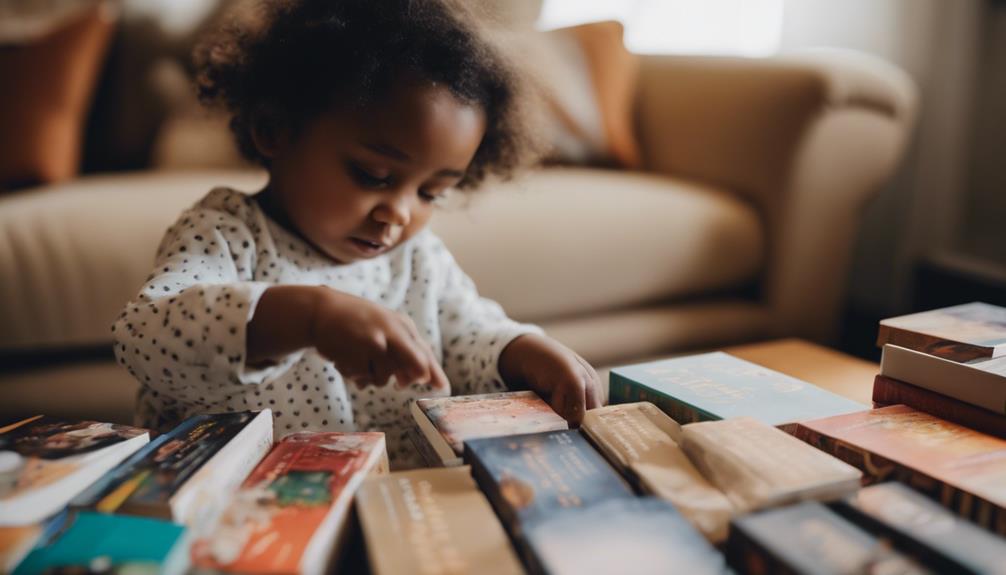
Selecting books that align with your baby's developmental stage and sensory preferences is essential for fostering a love for reading at an early age. When choosing books for your little one, consider the following:
- Pictures: Opt for books with vibrant colors and simple illustrations to captivate your baby's attention and stimulate visual development.
- Simple Board Books: Choose sturdy board books with durable pages that can withstand your baby's exploration and tactile interactions.
- Interactive Features: Look for books with textures, flaps, and mirrors to engage your baby's senses and encourage hands-on exploration during reading time.
- Rhythmic Language: Select books with rhythmic language and repetitive patterns to help your baby anticipate the story's flow and actively participate in reading sessions.
Making Reading Fun

To make reading fun for your little one, incorporate interactive books with sensory elements like textures and sounds. These types of books engage your child's senses and make the reading experience more enjoyable.
Picture books with simple plots and engaging illustrations can also capture your toddler's interest in reading. By choosing books that appeal to your child's senses and curiosity, you create a positive association with reading from a young age.
Repetition of favorite books can further enhance the fun factor, as it creates a sense of familiarity and comfort for your child. Encouraging your little one to enjoy books through various methods such as funny sound effects, songs, and library visits can turn reading into an exciting ritual for both of you.
Encouraging Curiosity About Words
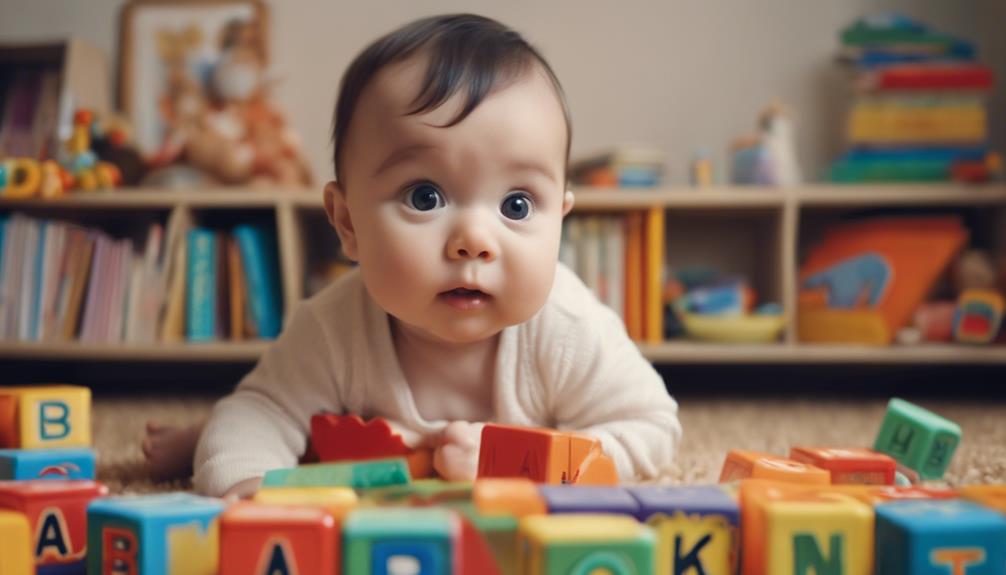
Introduce your baby to books with simple words and bright pictures to spark curiosity about words and encourage their language development through everyday interactions and engaging activities.
To foster your baby's curiosity about words and aid in their learning to read, consider the following:
- Point out signs, logos, and labels in the environment to help your baby recognize and associate words with objects.
- Engage in conversations with your baby, using descriptive language to expand their vocabulary and understanding of words.
- Play interactive word games like peek-a-boo with words or flashcards to make learning about words fun and engaging.
- Use everyday activities like mealtime or bath time to introduce new words and reinforce your baby's curiosity about language.
Progress Monitoring
Monitor your baby's progress by observing their interest in books, attention span during reading sessions, and ability to recognize letters or words.
Look for signs of readiness such as pointing to pictures, turning pages, imitating sounds or words, and showing excitement during reading time.
Keep track of any improvements in vocabulary, comprehension, and overall engagement with reading materials to adjust your teaching methods accordingly.
Reading Readiness Signs
Observe your baby's interest in books and stories as a key indicator of reading readiness. When considering when to start teaching your child to read, it's important to pay attention to specific signs that indicate their readiness.
To gauge your baby's readiness for reading instruction, look for the following indicators:
- Recognition of letters, sounds, and words: Watch if your baby shows interest in letters and attempts to repeat sounds.
- Ability to follow simple storylines or sequences: Notice if your baby can follow a basic storyline in a book or understand simple sequences of events.
- Curiosity about words and meanings: Observe whether your baby shows interest in words, their meanings, or asks questions about them.
- Interest in books and reading: Look for signs of excitement when your baby sees books or shows interest in being read to.
These signs can help you determine if your baby is ready to start learning how to read.
Adjusting Teaching Methods
To effectively adapt your teaching strategies when teaching your baby to read, pay attention to their responses and engagement with reading activities. Monitoring your baby's progress is vital in adjusting teaching methods. Look for signs of readiness, such as their interest in books, ability to follow stories, and recognition of letters and sounds.
Tracking your baby's curiosity about words and meanings helps tailor your teaching approach to their needs. According to the American Academy of Pediatrics, 'Parents should observe their child's receptive vocabulary and adjust the reading materials accordingly.' By observing your baby's world of literacy, you can better understand their developmental stage and adjust your methods accordingly.
If you notice any challenges in your baby's reading development, consider seeking guidance from educators or specialists. Adapting your teaching methods based on your baby's responses and progress is key to fostering a love for reading and building a strong foundation for literacy.
Adjusting to Individual Pace
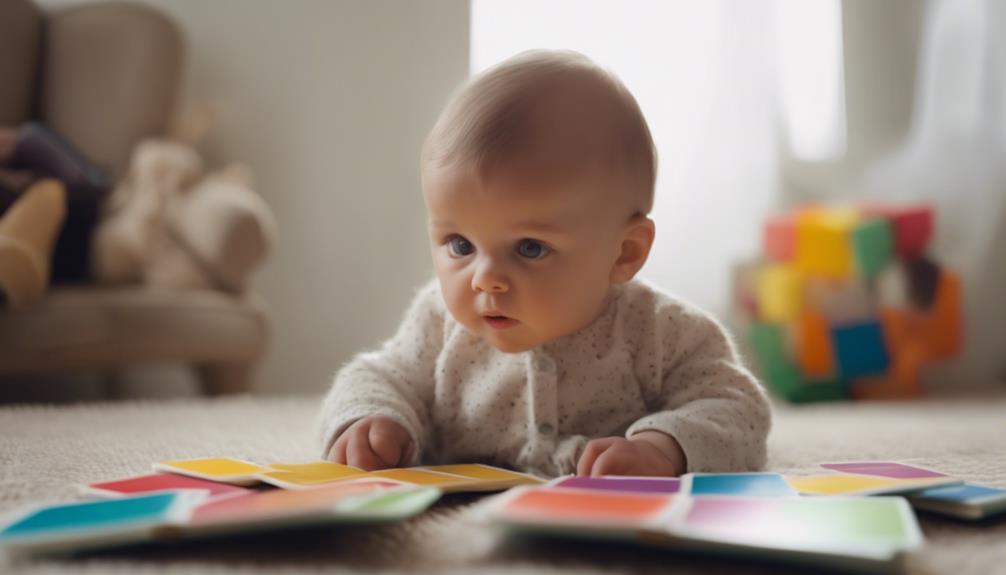
When teaching your baby to read, it's important to adjust to their individual pace of learning. Each child has a unique readiness for future success in learning to read.
To accommodate your baby's learning pace effectively, consider the following:
- Assess your baby's interest and attention span before starting reading instruction.
- Look for cues such as curiosity about words and storytelling.
- Consider the child's ability to follow sequences or stories as indicators.
- Create a positive and supportive environment for learning.
Understanding your baby's cues and abilities will help lay a strong foundation for their reading journey.
As one source mentioned, 'Adapting to your child's pace promotes a positive learning experience, setting the stage for future success.' By adjusting to your baby's individual pace, you can enhance their learning process and foster a love for reading that will benefit them in the long run.
Frequently Asked Questions
When Should I Introduce My Baby to Read?
You should introduce your baby to reading when they start showing interest. Look for cues like grabbing at books or paying attention to pictures. Follow their lead and make reading a fun, interactive experience.
Can a Child Read at 2 Years Old?
At 2 years old, a child's reading skills are still developing. Focus on building pre-reading skills and nurturing a love for books. Reading readiness typically emerges around 5-6 years old. Early exposure to books is essential.
When Should I Introduce My Child to Reading?
You should introduce your child to reading as early as possible. Starting early helps stimulate brain development, fosters a love for books, and strengthens the bond between you and your child. Reading together is a wonderful experience!
When Should I Start Reading to My Baby While Pregnant?
During pregnancy, start reading to your baby around 18-25 weeks gestation. Choose rhythmic books with soothing tones to stimulate brain development and create a calming environment. Reading aloud can help them recognize your voice and bond with you before birth.
Conclusion
To sum up, starting to teach your baby to read at an early age can have numerous benefits for their cognitive development. By exposing them to books, promoting reading readiness activities, and creating a reading routine, you can help them build a strong foundation for literacy skills.
Remember, every child is unique, so it's important to adjust to their individual pace. As the saying goes, 'A child who reads will be an adult who thinks.' Start early and watch their love for reading grow.

